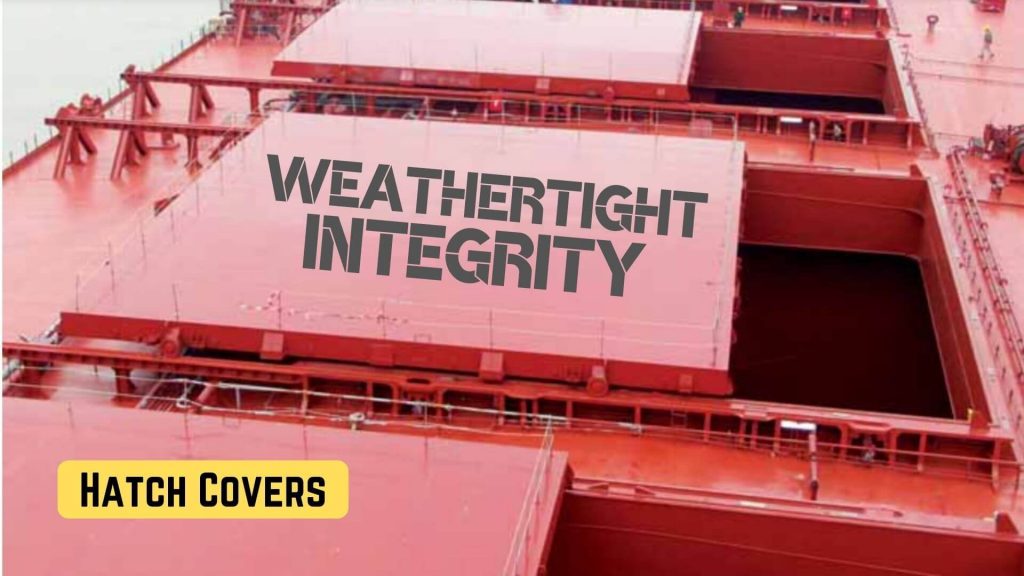
(www.MaritimeCyprus.com) The Shipowners Club in collaboration with Van Ameyde McAuslands has produced this advice on effective hatch cover maintenance for dry cargo ships including preventative action against ingress of water. Van Ameyde McAuslands have been providing advice and support to the marine industry since 1888. Founded in Hull, UK, the surveying team have a combined seagoing and surveying experience of over 400 years. In April 2019 they became a member of the Van Ameyde Group, further strengthening their depth of expertise and reach. The Club would like to thank Van Ameyde McAuslands for their invaluable assistance in producing this advice.
One of the key requirements in cargo vessel operations is ensuring that the cargo is delivered to the discharge port in the same condition in which it was loaded. Despite improvements in the methods for ensuring that hatch covers are weathertight, Members continue to experience claims for wetted cargo that has resulted from water ingress through hatch covers.
HATCH COVER DESIGN
Hatch cover designs vary extensively such as folding, pivoting, stacking and side rolling, all dependent on the type of cargo vessel they are to be fitted on. However, the key purpose for all designs remains the same in that they are there to prevent water ingress into the cargo holds. This sceanrio of water entering the holds through the hatch covers is a common cause of cargo damage claims largely attributed to:
- Incorrect closure/securing
- Poor maintenance
- Lack of routine testing
Hatch covers are large, steel structures with individual components that can weigh up to 30 tonnes. They are strong, rigid structures. However, if even a small area of rubber seal is missing or there’s an incorrect alignment of just a few millimetres, the covers can be rendered ineffective and lead to extensive water ingress. The financial consequences of such incidents can be great.

CLOSURE AND SECURING OF HATCH COVERS
In order to ensure that hatch covers are closed sufficiently it is vital that the correct procedures are followed every time the hatches are closed and opened. This can be achieved by ensuring that crew are duly familiar with the manufacturer’s operating instructions, the company’s on board operation procedures, risk assessments and any other relevant policies related to these operations.
Occasionally, charterers or shippers may request that additional measures are taken to seal the hatch covers, regardless of their condition. Such request should always be treated with caution as temporary sealing measures such as Ram-Nek tape, expandable foam or tarpaulin (if not part of the vessel’s certified design) often imply that there is an underlying defect with the hatch cover securing arrangement. It cannot be emphasised more that these measures should be resisted with charterers, with the best course of action being to demonstrate the weathertight integrity of hatch covers without said additional temporary measures.
MAINTENANCE
Poor maintenance can greatly increase the likelihood of hatch covers failing and leaking during periods of heavy weather. Whilst the hatch cover sealing rubber plays an important role as a barrier against sea water ingress, it is not the only means of preventing water from entering the cargo hold. Cargo is protected from minor leaks through inner drainage channels which will direct water away from the holds to drainage points, preventing the wetting of cargo. It is therefore crucial that not only is the compression bar on which the hatch rubber sits in good condition, but also that the inner sill of the drainage channel is free from damage.

As demonstrated in Figure 2, damage or warping to the inner sill can be caused by contact with the cargo itself or cargo gear such as grabs, chutes or chains. In these cases it is strongly recommended that permanent repairs are carried out as soon as possible. While the hatch cover seals themselves may be well maintained, if other parts of the hatch cover sealing arrangement are in poor working condition or compromised, cargo wetting could occur, resulting in exposure to high quantum claims.
 |  |
| Figure 3: Overflowing drainage channels | Figure 4: Non-return valve not fitted to the drainage arrangement |
It is also essential that this drainage system does not become blocked as if it does, the water has no path to drain into and may spill over into the cargo hold, damaging the cargo (reference Figure 3). The water in this drainage channel should pass through a non-return valve installed at the end point and not through an open pipe or section of fire hose. It must be noted that if a non-return valve is not fitted, heavy seas can flow in the opposite direction, into the cargo hold (reference figure 4). These non-return valves should be removable or enable easy access for cleaning to prevent blockage of drainage pipes.
 |  |
| Figure 5: Hardened indented rubber seals | Figure 6: Section replacement of rubber sealHardened indented rubber seals |
Hatch cover rubber seals need to be kept in good condition and show even levels of compression. They should never be allowed to become hardened (reference Figure 5), heavily compressed or perished. In an effort to minimise repair costs, it may be the case that only small parts of a length of hatch rubber are replaced when damaged. This should always be avoided as small repaired areas may lead to uneven compression and gaps in the rubber through which water could pass easily (reference figure 6).
Cargo hatch covers are not the only area that should be effectively maintained, other openings such as access hatches and ventilators should also receive the same due care and attention. These components do not just protect cargoes that are carried on vessels, they also safeguard the lives of crews that work on board.
TESTING TO VERIFY HATCH COVERS ARE WEATHERTIGHT
Members may be familiar with the hose testing method which can be carried out on a regular basis by the crew. These tests will not guarantee that the hatches are weathertight but will confirm if the hatches are likely to leak. These tests also enable remedial measures to be undertaken to address issues that have been identified prior to the vessel’s departure. Hose tests should be carried out in the calm, still waters of a port.
Another test method is ultrasonic testing and it is strongly advised that this is conducted at routine intervals in order to demonstrate the weathertight integrity of the vessel’s hatches. This will assist to defend the Member’s position in the event of a related claim.
Whilst there is no statutory requirement or industry guidance on the frequency of third party verification of hatch cover weathertight integrity, the Club strongly recommends that such tests should be conducted at intervals not exceeding 12 months.
If focus is given to the three core areas mentioned in this guidance (proper procedures, effective maintenance and regular testing) then this will assist greatly in the prevention of wet cargo claims whilst ensuring vessel safety.
Click below to download the guidance in pdf format:
Source: Shipowners Club
More resources on Hatch covers:
Maritime Risk Focus: Hatch Covers considerations
Loss Prevention: Cargo claims related to leaking hatch covers














